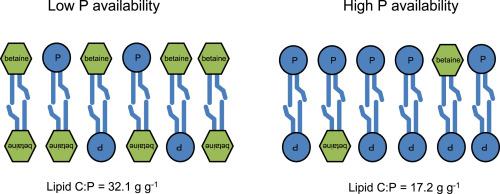当前位置:
X-MOL 学术
›
Soil Biol. Biochem.
›
论文详情
Our official English website, www.x-mol.net, welcomes your feedback! (Note: you will need to create a separate account there.)
Phosphorus drives adaptive shifts in membrane lipid pools and synthesis between soils
Soil Biology and Biochemistry ( IF 9.7 ) Pub Date : 2024-03-04 , DOI: 10.1016/j.soilbio.2024.109387 Charles R. Warren , Orpheus M. Butler
Soil Biology and Biochemistry ( IF 9.7 ) Pub Date : 2024-03-04 , DOI: 10.1016/j.soilbio.2024.109387 Charles R. Warren , Orpheus M. Butler

|
Phospholipids are key constituents of microbial membranes and account for a substantial fraction of microbial P, while P-free betaine lipids provide a pathway for membrane synthesis independent of P. The aim of this study was to test if modulation of relative amounts of phospholipids vs P-free betaine lipids is a response to P availability. To examine responses of membrane lipids to P availability, we added P or P + C to an extremely P-poor sandstone-derived soil (total P = 41 μg g) and a higher P shale-derived soil (total P = 201 μg g). By using DO labelling and LC-MS we were able to disentangle membrane lipid synthesis dependent on P (i.e. H incorporation into phospholipids) from membrane lipid synthesis independent of P (i.e. H incorporation into P-free betaine lipids). In unamended soils, P-free betaine lipids were almost 60% of the membrane lipid pool of the P-poor sandstone-derived soil, but only 10% of the higher-P shale-derived soil. Hence, to produce a unit of membrane lipid, the microbial population of sandstone soil required only 54% as much P as the microbial population of shale soil. Four days after adding P to the sandstone soil, phospholipids accounted for a larger proportion of the pool and synthesis of membrane lipids while pool and synthesis of P-free betaine lipids decreased. The increased allocation to phospholipids in sandstone soil amended with P likely reflected amelioration of P limitation given that P addition did not affect pools or synthesis of phospholipids versus betaine lipids in the higher-P shale soil. Collectively these data support the idea that having membranes with a high proportion of P-free betaine lipids is a key adaptive trait of microbial populations of P-poor soil, while the plasticity afforded by membrane lipid remodelling enables short-term fine-tuning of membrane lipid composition to P availability.
中文翻译:

磷驱动膜脂质池和土壤之间合成的适应性变化
磷脂是微生物膜的关键成分,占微生物磷的很大一部分,而不含磷的甜菜碱脂质提供了一条独立于磷的膜合成途径。本研究的目的是测试磷脂相对量与磷的相对量的调节是否-游离甜菜碱脂质是对磷可用性的反应。为了检查膜脂对 P 有效性的响应,我们将 P 或 P + C 添加到极度贫磷的砂岩土壤(总 P = 41 µg g)和较高 P 的页岩土壤(总 P = 201 µg g)中。 )。通过使用 DO 标记和 LC-MS,我们能够将依赖于 P 的膜脂质合成(即 H 掺入磷脂中)与独立于 P 的膜脂质合成(即 H 掺入不含 P 的甜菜碱脂质中)分开。在未改良的土壤中,无磷甜菜碱脂质几乎占贫磷砂岩土壤膜脂库的 60%,但仅占高磷页岩土壤的 10%。因此,为了生产一单位的膜脂,砂岩土壤的微生物种群所需的磷量仅为页岩土壤微生物种群的 54%。砂岩土中添加磷后4天,膜脂的库和合成中磷脂所占比例较大,而无磷甜菜碱脂的库和合成则减少。考虑到磷的添加不影响高磷页岩土壤中磷脂库或磷脂与甜菜碱脂质的合成,用磷修正的砂岩土壤中磷脂分配的增加可能反映了磷限制的改善。总的来说,这些数据支持这样的观点,即具有高比例的无磷甜菜碱脂质的膜是贫磷土壤微生物群体的一个关键适应性特征,而膜脂质重塑提供的可塑性使得膜的短期微调成为可能。脂质组成与 P 利用率的关系。
更新日期:2024-03-04
中文翻译:

磷驱动膜脂质池和土壤之间合成的适应性变化
磷脂是微生物膜的关键成分,占微生物磷的很大一部分,而不含磷的甜菜碱脂质提供了一条独立于磷的膜合成途径。本研究的目的是测试磷脂相对量与磷的相对量的调节是否-游离甜菜碱脂质是对磷可用性的反应。为了检查膜脂对 P 有效性的响应,我们将 P 或 P + C 添加到极度贫磷的砂岩土壤(总 P = 41 µg g)和较高 P 的页岩土壤(总 P = 201 µg g)中。 )。通过使用 DO 标记和 LC-MS,我们能够将依赖于 P 的膜脂质合成(即 H 掺入磷脂中)与独立于 P 的膜脂质合成(即 H 掺入不含 P 的甜菜碱脂质中)分开。在未改良的土壤中,无磷甜菜碱脂质几乎占贫磷砂岩土壤膜脂库的 60%,但仅占高磷页岩土壤的 10%。因此,为了生产一单位的膜脂,砂岩土壤的微生物种群所需的磷量仅为页岩土壤微生物种群的 54%。砂岩土中添加磷后4天,膜脂的库和合成中磷脂所占比例较大,而无磷甜菜碱脂的库和合成则减少。考虑到磷的添加不影响高磷页岩土壤中磷脂库或磷脂与甜菜碱脂质的合成,用磷修正的砂岩土壤中磷脂分配的增加可能反映了磷限制的改善。总的来说,这些数据支持这样的观点,即具有高比例的无磷甜菜碱脂质的膜是贫磷土壤微生物群体的一个关键适应性特征,而膜脂质重塑提供的可塑性使得膜的短期微调成为可能。脂质组成与 P 利用率的关系。



























 京公网安备 11010802027423号
京公网安备 11010802027423号